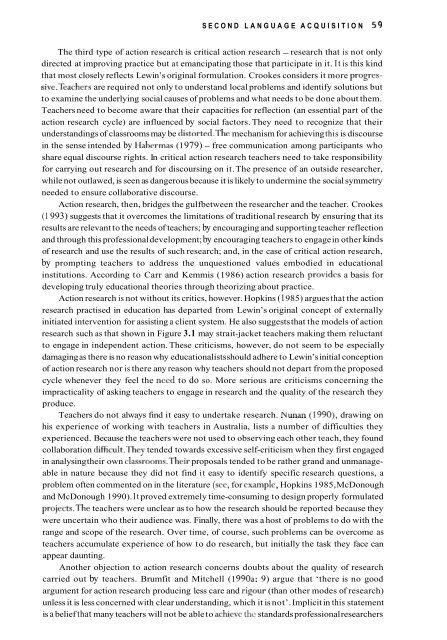English Language Teaching in its Social Context
English Language Teaching in its Social Context
English Language Teaching in its Social Context
Create successful ePaper yourself
Turn your PDF publications into a flip-book with our unique Google optimized e-Paper software.
SECOND LANGUAGE ACQUISITION 59The third type of action research is critical action research - research that is not onlydirected at improv<strong>in</strong>g practice but at emancipat<strong>in</strong>g those that participate <strong>in</strong> it. It is this k<strong>in</strong>dthat most closely reflects Lew<strong>in</strong>’s orig<strong>in</strong>al formulation. Crookes considers it more progressive.Teachersare required not only to understand local problems and identify solutions butto exam<strong>in</strong>e the underly<strong>in</strong>g social causes of problems and what needs to be done about them.Teachers need to become aware that their capacities for reflection (an essential part of theaction research cycle) are <strong>in</strong>fluenced by social factors. They need to recognize that theirunderstand<strong>in</strong>gs of classrooms may be distorted.The mechanism for achiev<strong>in</strong>g this is discourse<strong>in</strong> the sense <strong>in</strong>tended by Habermas (1 979) - free communication among participants whoshare equal discourse rights. In critical action research teachers need to take responsibilityfor carry<strong>in</strong>g out research and for discours<strong>in</strong>g on it. The presence of an outside researcher,while not outlawed, is seen as dangerous because it is likely to underm<strong>in</strong>e the social symmetryneeded to ensure collaborative discourse.Action research, then, bridges the gulfbetween the researcher and the teacher. Crookes(1 993) suggests that it overcomes the limitations of traditional research by ensur<strong>in</strong>g that <strong>its</strong>results are relevant to the needs of teachers; by encourag<strong>in</strong>g and support<strong>in</strong>g teacher reflectionand through this professional development; by encourag<strong>in</strong>g teachers to engage <strong>in</strong> other hndsof research and use the results of such research; and, <strong>in</strong> the case of critical action research,by prompt<strong>in</strong>g teachers to address the unquestioned values embodied <strong>in</strong> educational<strong>in</strong>stitutions. Accord<strong>in</strong>g to Carr and Kemmis (1986) action research providcs a basis fordevelop<strong>in</strong>g truly educational theories through theoriz<strong>in</strong>g about practice.Action research is not without <strong>its</strong> critics, however. Hopk<strong>in</strong>s (1 985) argues that the actionresearch practised <strong>in</strong> education has departed from Lew<strong>in</strong>’s orig<strong>in</strong>al concept of externally<strong>in</strong>itiated <strong>in</strong>tervention for assist<strong>in</strong>g a client system. He also suggests that the models of actionresearch such as that shown <strong>in</strong> Figure 3.1 may strait-jacket teachers mak<strong>in</strong>g them reluctantto engage <strong>in</strong> <strong>in</strong>dependent action. These criticisms, however, do not seem to be especiallydamag<strong>in</strong>g as there is no reason why educationalists should adhere to Lew<strong>in</strong>’s <strong>in</strong>itial conceptionof action research nor is there any reason why teachers should not depart from the proposedcycle whenever they feel the nccd to do so. More serious are criticisms concern<strong>in</strong>g theimpracticality of ask<strong>in</strong>g teachers to engage <strong>in</strong> research and the quality of the research theyproduce.Teachers do not always f<strong>in</strong>d it easy to undertake research. Nunan (1990), draw<strong>in</strong>g onhis experience of work<strong>in</strong>g with teachers <strong>in</strong> Australia, lists a number of difficulties theyexperienced. Because the teachers were not used to observ<strong>in</strong>g each other teach, they foundcollaboration difficult.They tended towards excessive self-criticism when they first engaged<strong>in</strong> analys<strong>in</strong>g their own classrooms.Their proposals tended to be rather grand and unmanageable<strong>in</strong> nature because they did not f<strong>in</strong>d it easy to identify specific research questions, aproblem often commented on <strong>in</strong> the literature (see, for examplc, Hopk<strong>in</strong>s 1985, McDonoughand McDonough 1990). It proved extremely time-consum<strong>in</strong>g to design properly formulatedprojects.The teachers were unclear as to how the research should be reported because theywere uncerta<strong>in</strong> who their audience was. F<strong>in</strong>ally, there was a host of problems to do with therange and scope of the research. Over time, of course, such problems can be overcome asteachers accumulate experience of how to do research, but <strong>in</strong>itially the task they face canappear daunt<strong>in</strong>g.Another objection to action research concerns doubts about the quality of researchcarried out by teachers. Brumfit and Mitchell (1 990a: 9) argue that ‘there is no goodargument for action research produc<strong>in</strong>g less care and rigour (than other modes of research)unless it is less concerned with clear understand<strong>in</strong>g, which it is not’. Implicit <strong>in</strong> this statementis a belief that many teachers will not be able to acheve the standards professional researchers












